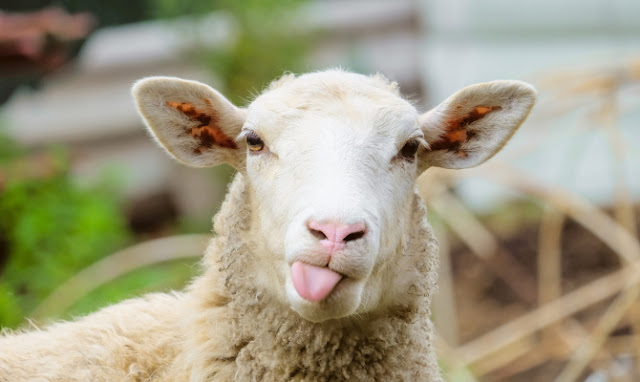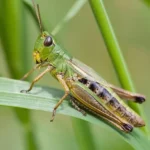
Sheep are quadrupedal, ruminant mammals typically kept as livestock.
Sheep is social animal. It likes to be part of the group and to follow the leader toward the new pastures.
Although the name “sheep” applies to many species in the genus Ovis, in everyday usage it almost always refers to domestic sheep (Ovis aries).
Sheep communicate with each other via bleating, grunting and snorting sounds.
Sheep are raised for their wool, hair or pelts as well as milk and meat.
Sheep usually breed during the autumn and winter (certain breeds mate all year round). Male, known as ram, can mate with 30 to 35 females during the breeding season (during a period of 60 days).
Sheep may be the first domesticated ruminant, tamed by nomadic people in the Middle East and Asia 11,000 years ago, perhaps even before agriculture gave rise to civilization.
Pregnancy in ewes (females) lasts 145 to 155 days and ends with 1 to 3 babies (lambs). Babies can stand on their feet from the moment of birth. Ewes form strong bonds with their offspring and bleat to find them in the herd (when they wander off). Lambs are fully weaned at the age of 2 to 3 months.
The exact line of descent between domestic sheep and their wild ancestors is unclear. The most common hypothesis states that domestic sheep aries is descended from the Asiatic (O. orientalis) species of mouflon.
Sheep were regarded as sacred animals in the ancient Egypt. Mummified sheep can be found in the tombs of some pharaohs.
Woolly sheep began to be developed around 6000 BC in Iran, and cultures such as the Persians relied on sheep’s wool for trading. They were then imported to Africa and Europe via trading.
Position of the ears and facial expression show emotional state of the sheep.
Today, sheep live worldwide in association with humans.
It is estimated that there are more than 200 distinct sheep breeds; some sources give a count of a 1000 or more breeds, but these numbers cannot be verified, according to some sources.
They are extremely versatile and exist in a wide variety of habitats worldwide ranging from temperate mountain forests to desert conditions.
The average lifespan of a sheep is 10 to 12 years, though some sheep may live as long as 20 years.
Sheep knows what to eat when it doesn’t feel well. It recognizes and eats plants with known healing potential to cure itself.
An adult female sheep is known as a ewe and an adult male sheep is known as a ram. A young sheep between newborn and 14 months old is called a lamb.
The physical details of domestic sheep vary greatly among breeds. Head and body length is 120-180 centimeters and shoulder height is 65-127 cm. They weigh between 45 and 100 kilograms (100 and 350 lb). Female sheep tend to be three quarters to two thirds the size of males.
Colors of domestic sheep range from pure white to dark chocolate brown, and even spotted or piebald.
While originally all rams had horns, sheep can have horns or not, depending upon their breed, sex, and genetics. In some sheep breeds, both sexes are horned. In some breeds, only the rams have horns.
Sheep has good memory and ability to recognize face of 50 different individuals (both of other sheep and humans). Despite the widespread belief that sheep are stupid, they are actually very intelligent animals (slightly less intelligent than pigs), capable of solving various problems.
Sheep have good hearing, and are sensitive to noise when being handled. Sheep have horizontal slit-shaped pupils, with excellent peripheral vision; with visual fields of about 270° to 320°, sheep can see behind themselves without turning their heads. Sheep also have an excellent sense of smell.
Sheep follow a diurnal pattern of activity, feeding from dawn to dusk.
Sheep are exclusively herbivorous mammals. They mostly eat grass, clover, forbs, and other pasture plants. Sheep especially love forbs. In fact, it is usually their first choice of food in a pasture. A forb is a broad-leaf plant other than grass. It is a flowering plant. Forbs are often very nutritious. As compared to cattle, sheep eat a greater variety of plants and select a more nutritious diet. Other than forage, the other staple feed for sheep is hay, often during the winter months.
Sheep is a grazer. Its diet is based on different types of grass. Sheep consumes 2 to 4.5 pounds of food per day.
Sheep belong to the ruminant classification of animals. Ruminants are characterized by their four-chambered stomach and “cud-chewing” behavior. Cud is a food bolus that is regurgitated, rechewed, and reswallowed.
Sheep are extremely social animals. In fact, they are “flock” animals, meaning that they prefer to be with other sheep. The dominance hierarchy of sheep and their natural inclination to follow a leader to new pastures were the pivotal factors in sheep being one of the first domesticated livestock species.
Sheep establish a dominance hierarchy through fighting, threats and competitiveness.
Sheep follow a similar reproductive strategy to other herd animals. A group of ewes is generally mated by a single ram, who has either been chosen by a breeder or has established dominance through physical contest with other rams. After mating, sheep have a gestation period of about five months; most lambs born in mid spring. One or two lambs, which are able to stand and suckle within a few minutes of birth, are born to each ewe.
Sheep has field vision of around 300 degrees (it can see behind its head), but it has poor depth perception. Sheep compensates its poor eyesight with excellent sense of hearing.
Today, there are little over one billion sheep on the planet.
The major national producers are China, Australia, New Zealand, India, U.S., Sudan, Nigeria, Argentina, Turkey and Pakistan.
Religious symbolism and ritual involving sheep began with some of the first known faiths: Skulls of rams (along with bulls) occupied central placement in shrines at the Çatalhöyük settlement in 8,000 BC.
In Ancient Egyptian religion, the ram was the symbol of several gods: Khnum, Heryshaf and Amun.
Most species of sheep have spiral horns. Sheep are born with long tail that is often docked at birth to prevent accumulation of dirt.
In Madagascar, sheep were not eaten as they were believed to be incarnations of the souls of ancestors.
Sheep play an important role in all the Abrahamic faiths; Abraham, Isaac, Jacob, Moses, King David and the Islamic prophet Muhammad were all shepherds.
Sheep has an average lifespan 6 to 12 years.
Followers of Christianity are collectively often referred to as a flock, with Christ as the Good Shepherd, and sheep are an element in the Christian iconography of the birth of Jesus.
Sheep is covered with wool that can be fine (soft), of medium quality or coarse. Wool can be short or long, milky white, brown or black-colored.
Christ is also portrayed as the Sacrificial lamb of God (Agnus Dei) and Easter celebrations in Greece and Romania traditionally feature a meal of Paschal lamb.
Greeks and Romans sacrificed sheep regularly in religious practice, and Judaism once sacrificed sheep as a Korban (sacrifice), such as the Passover lamb.
Astrologically, Aries, the ram, is the first sign of the classical Greek zodiac, and the sheep is the eighth of the twelve animals associated with the 12-year cycle of in the Chinese zodiac, related to the Chinese calendar.
Counting sheep is a mental exercise used in some cultures as a means of putting oneself to sleep. In most depictions of the activity, the practitioner envisions an endless series of identical white sheep jumping over a fence, while counting them as they do so. The idea, presumably, is to induce boredom while occupying the mind with something simple, repetitive, and rhythmic, all of which are known to help humans sleep.
Sheep can reach 25 to 50 inches in height (at the shoulders) and 99 to 353 pounds of weight.
Probably the most famous sheep was Dolly the Sheep. She was named after Dolly Parton, and was the first large mammal clone. She did not live as long as a regular sheep, because clones have health problems. This is only known because of Dolly.
The highest price ever achieved for a sheep is $369,000, paid by Jimmy Douglas for the eight-month-old Texel tup, Deveronvale Perfection, in Lanark, Scotland, in August 2009. Bred in Banffshire sheep farmer Graham Morrison, this very valuable sheep will be used for breeding purposes.
Turkish sheep die in “mass jump.” First one sheep went over the cliff edge, only to be followed by the whole flock, according to the reports. More than 400 sheep died in the 15-metre (50-foot) fall – their bodies cushioning the fall of 1,100 others who followed. Apparent suicide isn’t unheard of in animals.
Sheep can recognize emotions in facial expression, not only in their species but also in humans, researchers say.
The sight of sheep grazing on the south lawn of the White House may seem unusual, but during World War I, it was a highly visible symbol of home front support of the troops overseas. The flock, which numbered 48 at its peak, saved manpower by cutting the grass and earned $52,823 for the Red Cross through an auction of their wool.
Sheep FAQs: All About the Woolly Wonders
Sheep are familiar farmyard animals with a rich history and interesting behaviors. Here are some FAQs to satisfy your curiosity about these beloved creatures:
General
-
What are sheep? Sheep are domesticated ruminant mammals belonging to the Caprinae family, along with goats. They are known for their thick fleece (wool) and are primarily raised for their wool, meat (lamb), and milk.
-
Where did sheep originate from? The exact origin of sheep domestication is debated, but evidence suggests it occurred in southwestern Asia around 11,000 years ago. From there, sheep spread throughout Europe, Africa, and eventually the rest of the world.
-
What are the different breeds of sheep? There are hundreds of sheep breeds worldwide, each with unique characteristics. Some common breeds include Merino (known for fine wool), Suffolk (meat sheep), and Romney (dual-purpose wool and meat). Breeds can also be categorized by their fleece type (wool, hair, or a combination), tail type (long or short), and facial color (white or colored).
Biology and Behavior
-
What do sheep eat? Sheep are herbivores and primarily graze on grass, leaves, and other vegetation. They have a four-chambered stomach that allows them to efficiently digest plant material. In winter or during periods of limited forage, sheep may be supplemented with hay or grain.
-
How do sheep see? Sheep have excellent panoramic vision, with nearly 360-degree horizontal vision thanks to their laterally positioned eyes. This allows them to be aware of predators approaching from almost any direction. However, their depth perception is not as strong as human vision.
-
Are sheep intelligent? Sheep are often portrayed as simple creatures, but research suggests they are actually quite intelligent. They have good memories, can recognize faces (including human faces), and can learn to solve simple puzzles. Sheep are also social animals and form strong bonds with other sheep in their flock.
-
How do sheep communicate? Sheep communicate through a variety of vocalizations, including baaing (familiar to most!), bleating, and maaing. These vocalizations can convey different meanings depending on the pitch, length, and repetition. Body language also plays a role in sheep communication, with ear position, tail posture, and head movements all sending social signals.
Care and Products
-
How are sheep raised? Sheep farming practices vary depending on the region and purpose of raising sheep. Some sheep graze freely on pastures, while others may be kept in enclosures. Shearing typically happens once a year to remove the fleece, which is then processed into wool for various uses.
-
What are sheep used for? The primary products obtained from sheep are wool, meat (lamb), and milk. Wool is used for clothing, textiles, and insulation. Sheep meat is a popular source of protein around the world. Sheep milk is used to produce cheese and other dairy products, although it is less common than cow’s milk.
-
Is wool sustainable? Sustainable sheep farming practices are becoming increasingly important. Factors like responsible land management, humane treatment of animals, and minimizing environmental impact are all part of the equation.
These FAQs offer a glimpse into the fascinating world of sheep. From their origins and diverse breeds to their behavior and the products we obtain from them, sheep continue to play a significant role in agriculture and human culture.








